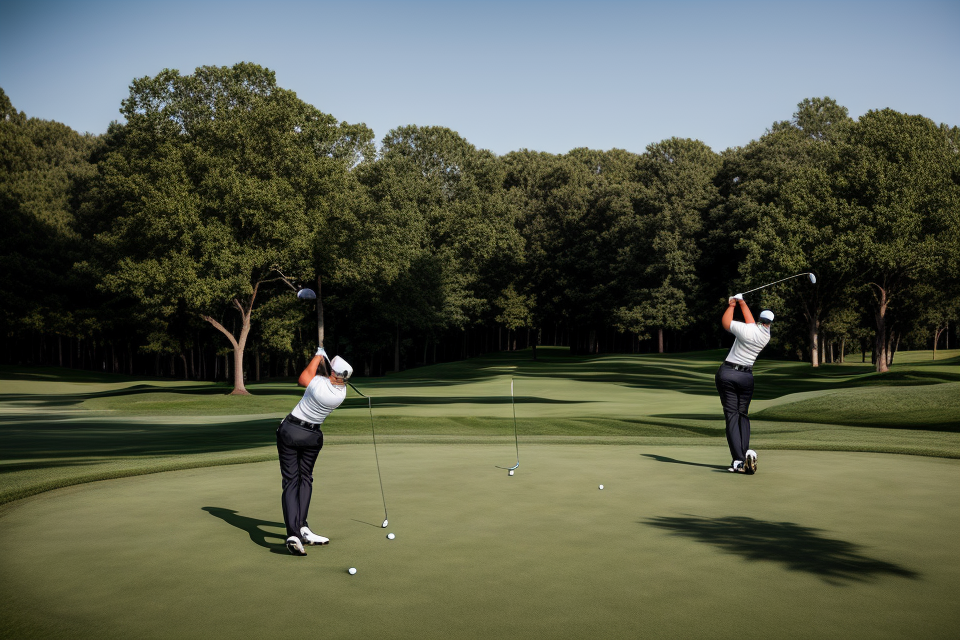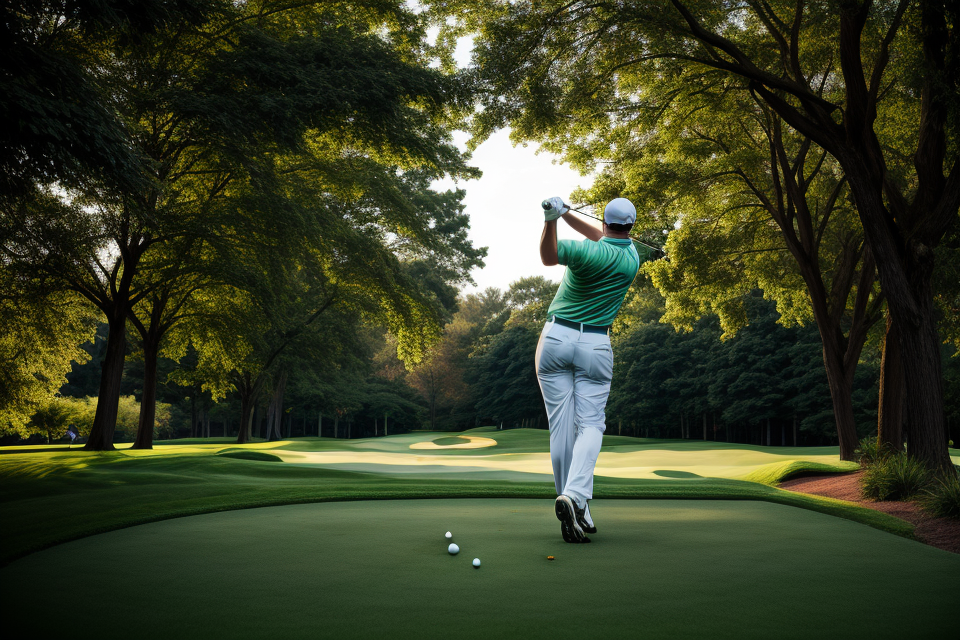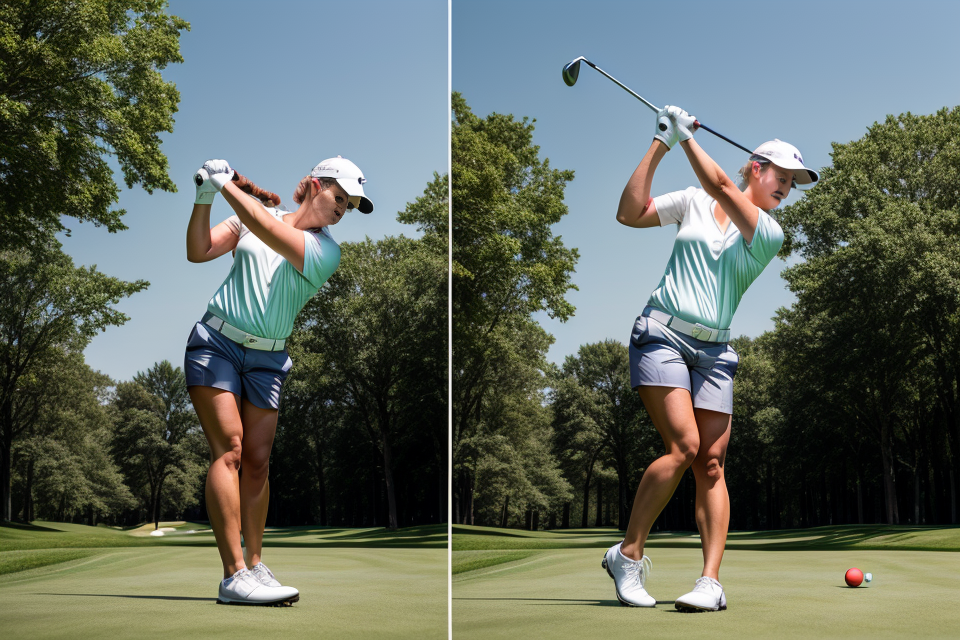
Golf is a sport that requires precision, patience, and practice. Improving your golf skills is not just about hitting the ball further or having a lower score, it’s about becoming a better golfer overall. To achieve this, there are several key areas to focus on, including physical conditioning, mental preparation, and technical skill development. In this article, we will explore practical tips and strategies for improving your golf game, so you can take your skills to the next level. Whether you’re a beginner or an experienced golfer, there’s always room for improvement, and with the right approach, you can achieve your goals on the course.
Improving your golf skills requires consistent practice and a commitment to learning the fundamentals of the game. Here are some tips to help you improve your golf skills:
1. Take lessons from a qualified golf instructor who can help you develop a personalized plan to improve your swing, putting, and chipping.
2. Practice regularly, both on the driving range and on the golf course. Focus on developing a smooth and consistent swing, and work on your mental game to help you stay focused and calm under pressure.
3. Pay attention to your physical fitness, as golf requires strength, flexibility, and endurance. Incorporate exercises that target the muscles used in golf, such as the legs, core, and upper body.
4. Use the right equipment, including golf clubs that are properly fitted to your body and golf balls that are appropriate for your skill level.
5. Finally, be patient and persistent. Improving your golf skills takes time and effort, but with dedication and hard work, you can become a better golfer.
Understanding the Fundamentals
Grip
One of the most crucial elements of a golfer’s game is their grip. A proper grip can help you control the club and hit accurate shots, while a faulty grip can lead to inconsistent results. In this section, we will discuss the correct grip for a golf club and how to adjust your grip for different shots.
The Correct Grip for a Golf Club
The grip is the first point of contact between you and the golf club. It is essential to have a secure and comfortable grip to ensure smooth movements and maintain control throughout the swing. The following steps will guide you in achieving the correct grip:
- Place the club at your side with the handle resting on your outer thigh.
- Place the fingers of your dominant hand (for right-handed golfers) around the grip, with the thumb resting against the inside of the index finger.
- Place the other hand on the grip, with the fingers wrapped around the dominant hand’s fingers. The palms should be facing each other.
- Adjust the grip size if necessary.
Adjusting Your Grip for Different Shots
A consistent grip is essential, but sometimes, you may need to adjust it slightly for different shots. Here are some tips on how to adjust your grip for various shots:
- Puttng: For putting, the grip should be light and relaxed, with the hands held softly. Keep the hands close together and let the fingers do the work.
- Chipping: Chipping requires a little more control, so the grip should be firmer than that of putting. The dominant hand’s thumb should be slightly extended, and the left hand should be positioned slightly further down the grip.
- Driving: For driving, the grip should be firm and confident, with the hands placed further down the grip. The dominant hand’s thumb should be in line with the index finger, and the left hand should be positioned slightly to the right of the right hand.
Remember, the grip is the foundation of your swing, and a poor grip can lead to inconsistent shots. By understanding the correct grip and learning how to adjust it for different shots, you can improve your golf skills and take your game to the next level.
Stance
A proper stance is essential for any golfer as it sets the foundation for a smooth and accurate swing. To establish a good stance, a golfer should position their feet shoulder-width apart, with the balls of their feet facing forward. It is important to keep the weight evenly distributed on both feet, with the majority of the weight on the front foot.
To adjust the stance for different shots, golfers should shift their weight and position their feet accordingly. For example, when taking a short shot, the golfer should move their feet closer together and lean towards the ball. Conversely, when taking a long shot, the golfer should move their feet further apart and maintain a more upright posture.
Additionally, golfers should pay attention to their hand positioning. The left hand should be placed on the grip with the palm facing towards the target, while the right hand should be placed on the grip with the palm facing away from the target. This hand positioning helps to maintain a strong grip on the club and promote a smooth swing.
Overall, a proper stance is crucial for any golfer, and adjusting the stance for different shots can greatly improve accuracy and overall performance.
Swing
The Basic Swing Mechanics
The swing is the most critical aspect of golf, and it requires a combination of physical and mental skills. To improve your swing, you must first understand the basic mechanics of the swing. This includes the grip, stance, and body alignment.
A proper grip is essential for a good swing. The grip should be relaxed, with the hands positioned comfortably on the club. The left hand should be placed on the grip, with the right hand positioned slightly lower. The fingers should be wrapped around the club, with the thumbs pointing downwards.
The stance is also critical for a good swing. The feet should be shoulder-width apart, with the weight evenly distributed on both feet. The knees should be slightly bent, and the hips should be rotated slightly forward. This position provides a stable base for the swing and allows for smooth movement.
Body alignment is also crucial for a good swing. The shoulders, hips, and feet should be aligned in the same direction as the target. This alignment ensures that the body moves in a straight line during the swing, resulting in a more accurate shot.
The Importance of the Follow-Through
The follow-through is the final stage of the swing, and it is crucial for maintaining balance and control. After hitting the ball, the hands should continue to move towards the target, with the clubhead following through to its maximum extent. This follow-through helps to maintain the momentum of the swing and ensures that the club returns to the correct position for the next shot.
The follow-through is also important for developing a smooth, consistent swing. By focusing on the follow-through, you can improve your timing and rhythm, which are essential for hitting accurate shots.
To improve your follow-through, practice swinging with a slow, controlled motion. Pay attention to the movement of your hands and clubhead, and make sure that they continue moving towards the target after impact. With practice, you can develop a smooth, powerful follow-through that will help you hit straighter, more accurate shots.
Improving Your Technique
Warm-up and Stretching
Warming up before a round of golf is essential for preparing your body for physical activity. A proper warm-up helps to increase blood flow to your muscles, boosts your metabolism, and elevates your heart rate. This prepares your body for the physical demands of golf and reduces the risk of injury.
In addition to a proper warm-up, stretching is also important for improving your golf skills. Stretching can help to improve flexibility, increase range of motion, and reduce the risk of injury.
Here are some stretches that can help improve your golf skills:
- Swinging Stretches: These stretches help to improve flexibility in the hips, legs, and lower back, which are essential for a proper golf swing. Examples include the butterfly stretch, the hamstring stretch, and the seated forward fold.
- Upper Body Stretches: These stretches help to improve flexibility in the shoulders, arms, and neck, which are essential for a proper golf swing. Examples include the shoulder roll, the neck stretch, and the wrist stretch.
- Core Stretches: These stretches help to improve flexibility in the core muscles, which are essential for balance and stability during a golf swing. Examples include the seated twist, the half-kneeling twist, and the standing forward fold.
Remember to hold each stretch for 15-30 seconds and repeat several times. It’s also important to stretch both sides of your body to ensure balance and avoid any imbalances that could lead to injury.
Practice Drills
- One of the most effective ways to improve your golf skills is by incorporating practice drills into your routine. These drills are designed to help you develop specific aspects of your game, such as your swing, putting, and chipping.
- Here are some common practice drills for improving your swing:
- The ball-toss drill: This drill involves tossing a ball straight up in the air and taking a swing at it as it comes down. This helps to develop your timing and rhythm.
- The impact bag drill: This drill involves hitting a golf ball into a mat or bag. This helps to improve your impact feel and ball control.
- The driver drill: This drill involves using a driver to hit a ball straight down the fairway. This helps to develop your power and accuracy.
- To get the most out of these drills, it’s important to incorporate them into your routine. Here are some tips for doing just that:
- Set aside time each day to practice. This could be as little as 10-15 minutes, but the more time you can dedicate to practice, the better.
- Choose one or two drills to focus on each day. This will help you stay focused and avoid becoming overwhelmed.
- Film yourself while you practice. This will help you identify any issues with your technique and make adjustments as needed.
- Practice with a purpose. Instead of just going through the motions, set specific goals for each practice session. For example, you might aim to improve your ball striking accuracy by 10% by the end of the week.
Mental Game
Golf is not just about physical technique, but also about the mental game. In fact, many top golfers attribute their success to their mental toughness and ability to stay focused under pressure. Here are some techniques for improving your mental game on the golf course:
- Visualization
Visualization is a powerful tool for improving your mental game. It involves mentally rehearsing your shots and visualizing yourself making them successfully. This can help you build confidence and reduce anxiety on the course. To practice visualization, find a quiet place where you can focus on your thoughts and imagine yourself making each shot. Start with the first tee shot and visualize yourself hitting it straight and true down the fairway. Move on to the next shot and so on, until you have visualized your entire round.
- Positive Self-Talk
Negative self-talk can be a major obstacle to improving your golf skills. Instead of berating yourself for a bad shot, try to focus on positive self-talk. This means using phrases like “I can do this” or “I’m a great golfer” to build yourself up and stay confident. Positive self-talk can help you stay focused and motivated, even when things aren’t going well on the course.
- Focus on the Present
Golf is a game of focus and concentration. It’s easy to get caught up in thoughts about past mistakes or future outcomes, but it’s important to stay focused on the present moment. This means being fully present on each shot and avoiding distractions like cell phones or chatter from other players. By focusing on the present, you can stay in the zone and perform at your best.
- Mindfulness
Mindfulness is a technique for staying present and focused on the moment. It involves paying attention to your thoughts and feelings without judgment, and cultivating a sense of awareness and acceptance. Mindfulness can help you stay calm and centered on the golf course, even in high-pressure situations. To practice mindfulness, try taking a few deep breaths before each shot and focusing on your breath. This can help you stay centered and calm, and reduce anxiety and distractions.
- Develop a Pre-Shot Routine
A pre-shot routine can help you get into the right mindset before each shot. This routine might include things like taking a few deep breaths, visualizing your shot, and repeating a positive mantra to yourself. By developing a pre-shot routine, you can establish a sense of consistency and routine on the course, which can help you stay focused and calm.
By improving your mental game, you can become a more consistent and successful golfer. These techniques can help you stay focused, build confidence, and reduce anxiety on the course, so you can perform at your best no matter what challenges you face.
Improving Your Equipment
Club Selection
Choosing the right clubs for your game is essential to improving your golf skills. Each club serves a different purpose, and selecting the right one for your shot can make a significant difference in your accuracy and distance. Here are some tips for choosing the right clubs for your game:
- Assess your game: Before selecting your clubs, it’s important to assess your game and determine your strengths and weaknesses. This will help you choose clubs that complement your swing and shot style.
- Consider the course conditions: Different courses have different conditions, such as weather, terrain, and grass type. Choosing clubs that are suitable for the course conditions can help you perform better.
- Choose the right loft: The loft of a club determines the height and distance of your shot. Choosing a club with the right loft for your shot can help you achieve the desired trajectory and distance.
- Adjust your clubs for different courses and conditions: Each course has its own unique characteristics, and it’s important to adjust your clubs accordingly. For example, you may need to use a different club for a shot over a hazard or a shot on a tight fairway.
By following these tips, you can select the right clubs for your game and improve your golf skills.
Ball Selection
When it comes to improving your golf skills, selecting the right ball for your game is crucial. Choosing the right ball can affect your shot distance, accuracy, and spin rate. Therefore, it is important to consider certain factors before selecting a golf ball.
Some factors to consider when selecting a golf ball are:
- Your swing speed: The speed at which you swing the club affects the ball’s distance and flight path. If you have a slower swing speed, you may want to choose a ball with a lower compression rating for more distance. If you have a faster swing speed, you may want to choose a ball with a higher compression rating for more control.
- Your skill level: Beginner golfers may want to choose a ball with a higher spin rate for more control, while advanced golfers may want to choose a ball with a lower spin rate for more distance.
- Course conditions: The conditions of the course, such as the wind and temperature, can affect the ball’s flight path. If you are playing in windy conditions, you may want to choose a ball with a higher spin rate for more control. If you are playing in hot conditions, you may want to choose a ball with a softer feel for more control around the greens.
- Your personal preferences: Ultimately, the ball you choose should feel comfortable to you and fit your personal preferences. You may want to try out different brands and models to find the one that feels best to you.
In conclusion, selecting the right ball for your game is an important factor in improving your golf skills. Consider your swing speed, skill level, course conditions, and personal preferences when choosing a ball. With the right ball, you can improve your shot distance, accuracy, and spin rate, and ultimately lower your score.
Course Management
- Tips for playing different types of courses
- Familiarize yourself with the course layout and its unique features before playing.
- Take note of the course’s elevation changes, water hazards, and bunkers to avoid costly mistakes.
- Pay attention to the wind direction and speed, which can significantly impact your shots.
- Strategies for managing your game on difficult holes
- Identify the problem hole: Analyze your past performances on the problem hole and identify the areas where you consistently struggle.
- Choose the right club: Consider the hole’s distance, wind conditions, and any hazards when selecting the appropriate club for your shot.
- Plan your approach: Develop a strategy for approaching the hole, such as aiming for the center of the green or using a lower lofted club to avoid hazards.
- Practice your short game: Spend extra time practicing your chipping and putting skills to improve your performance on difficult holes.
- Maintain a positive attitude: Remember that even the best golfers sometimes struggle on difficult holes. Maintain a positive attitude and focus on learning from your mistakes.
Physical Fitness
As a golfer, physical fitness is a crucial aspect of improving your skills. A strong and flexible body can help you improve your swing, increase your power, and reduce the risk of injury. Here are some exercises that can help you improve your physical fitness for golf:
Strength Training
Strength training is essential for golfers as it helps improve your power and control. Some exercises that can help you improve your strength include:
- Deadlifts
- Squats
- Lunges
- Bench press
- Shoulder press
- Bicep curls
- Tricep dips
It is important to include both heavy and lightweight exercises in your strength training routine to ensure that you are building both power and endurance.
Flexibility Training
Flexibility is also important for golfers as it helps improve your range of motion and reduce the risk of injury. Some exercises that can help you improve your flexibility include:
- Hamstring stretches
- Calf stretches
- Hip stretches
- Shoulder stretches
- Trunk stretches
It is important to hold each stretch for at least 20-30 seconds and repeat several times to improve your flexibility.
Cardiovascular Training
Cardiovascular training is important for golfers as it helps improve your endurance and overall fitness level. Some exercises that can help you improve your cardiovascular fitness include:
- Running
- Cycling
- Swimming
- Rowing
- Elliptical training
It is important to include at least 30 minutes of cardiovascular exercise in your routine at least three times a week to improve your endurance.
In conclusion, physical fitness is a crucial aspect of improving your golf skills. By incorporating strength training, flexibility training, and cardiovascular training into your routine, you can improve your power, range of motion, and endurance, and reduce the risk of injury.
Nutrition and Hydration
The Role of Nutrition and Hydration in Golf Performance
Golf is a sport that requires both physical and mental endurance. The ability to maintain focus, control your movements, and execute precise shots for an extended period depends on various factors, including your physical condition, mental state, and the quality of your equipment. Nutrition and hydration play a crucial role in golf performance, as they help maintain energy levels, support muscle function, and promote overall well-being.
Tips for Fueling Your Body Before, During, and After a Round of Golf
To optimize your golf performance, it’s essential to pay attention to your nutritional needs both on and off the course. Here are some tips to help you fuel your body effectively before, during, and after a round of golf:
- Pre-Game Nutrition: Eating a balanced meal a few hours before your tee time can help provide sustained energy throughout your round. Include complex carbohydrates, lean protein, and healthy fats in your pre-game meal to support your body’s energy demands. Avoid heavy, greasy, or spicy foods that may cause discomfort or indigestion.
- Hydration Before the Game: Staying well-hydrated before your round is essential to maintain proper blood volume and blood flow, which helps with focus and performance. Drink plenty of water in the hours leading up to your tee time, and avoid alcohol or caffeinated beverages that can dehydrate you.
- Snacks During the Game: Carrying healthy snacks like fruit, nuts, or energy bars in your golf bag can help maintain your energy levels and prevent low blood sugar during your round.
- Post-Game Nutrition: After your round, refuel with a meal or snack that includes a balance of carbohydrates and protein to replenish your energy stores and support muscle recovery.
- Staying Hydrated On-Course: Make sure to bring plenty of water with you on the course and drink regularly to maintain proper hydration. Avoid consuming excessive amounts of alcohol or sugary drinks, as they can lead to dehydration and negatively impact your performance.
By paying attention to your nutrition and hydration needs, you can enhance your golf performance, maintain energy levels, and support your overall well-being both on and off the course.
FAQs
1. What are the key elements to improve my golf skills?
The key elements to improve your golf skills are practice, patience, and persistence. Practice is essential to develop muscle memory and improve your technique. Patience is important because golf is a game of precision and accuracy, and it can take time to see improvements in your game. Persistence is crucial because golf is a challenging game, and it is easy to get frustrated and give up. It is important to stay motivated and focused on your goals.
2. How can I practice effectively to improve my golf skills?
To practice effectively, it is important to have a plan and set specific goals. You should also focus on specific aspects of your game that need improvement, such as your swing, putting, or chipping. It is also important to practice under different conditions, such as windy or rainy weather, to prepare for real-life scenarios. Finally, it is important to track your progress and make adjustments to your practice routine as needed.
3. What are some tips for improving my swing?
Some tips for improving your swing include using proper form, maintaining a smooth rhythm, and practicing consistently. It is also important to pay attention to your body positioning and alignment, as well as your grip and stance. You should also focus on maintaining a smooth and balanced swing, rather than trying to hit the ball too hard. Finally, it is important to practice your swing in slow motion and then gradually increase your speed as you become more comfortable.
4. How can I improve my putting skills?
To improve your putting skills, it is important to focus on your aim, stance, and stroke. You should also pay attention to the speed of your stroke, as well as your body positioning and alignment. It is also helpful to practice on different types of greens, such as uphill or downhill putts, to prepare for real-life scenarios. Finally, it is important to practice under pressure and to track your progress to identify areas for improvement.
5. What are some common mistakes to avoid when trying to improve my golf skills?
Some common mistakes to avoid when trying to improve your golf skills include getting frustrated and losing patience, trying to hit the ball too hard, and neglecting other aspects of your game. It is also important to avoid bad habits, such as slouching or using an incorrect grip. Finally, it is important to avoid comparing yourself to others and to focus on your own progress and goals.


